Painting the sky - Part 2 Venice Grand Canal scene
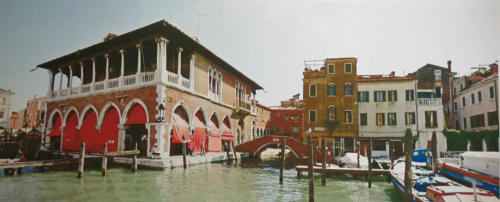
Before painting the sky of our Venice project which was started here, we will look at choosing the best blue. Then we will check out the techniques suitable for painting blue sky with watercolour pencils.
First, I must remind you that a totally blue sky is not the same blue all over! The next chance you get, look at a blue sky and compare the blue as you look to the horizon with the blue that you see directly overhead. The sky overhead is a stronger blue than the much paler version see in the distance.
There are also differences in the blue of a sky in the tropics with that in Northern climates.
This is nothing to worry about. For our tutorial we will probably only be showing a small amount of blue in a cloudy sky, so the actual blue isn't critical.
So, does it matter which brand of watercolour pencil and which blue from that tin you use? In a word, yes, but... use whatever you have available. If you dont use the Derwent Watercolour pencils that I am using, yours may have different variations of colour and softness therefore your picture will look different, but the principles of working will be the same and your end result will be YOUR version of the picture.
About watercolour pencils
I think it will be useful at this point to repeat some basics about watercolour pencils before we put colour to paper.
Different manufacturers have different ideas about how much pigment to put into the pencils - and also different ideas about exactly what Ultramarine Blue looks like (and any other named colour for that matter). Have a quick look at this chart which includes more than Ultramarine, but you will get the idea. I will go into the individual samples in a minute but this is just an overall view of the chart.
The first line of each sample is the colour worked dry with first a light shading on to the paper and then a heavier shading (which applies more pigment). The second line of each sample shows the impact of a damp brush with clean water.
The first thing you should notice is how different the wet and dry samples are, and how much stronger the colour is when it has been dissolved. Some brands are much more pigmented and therefore the differences between dry and wet is more pronounced. Often the darker colours go much stronger when wet (they have more pigment in them).
This is the TRAP that catches all those who try out watercolour pencils for the first time.
Before you start on a picture, you should have tested the colours on a piece of the paper that you will be using. This will alert you to any major shift in colour intensity and guide you over the amount of dry pigment to apply to the paper.
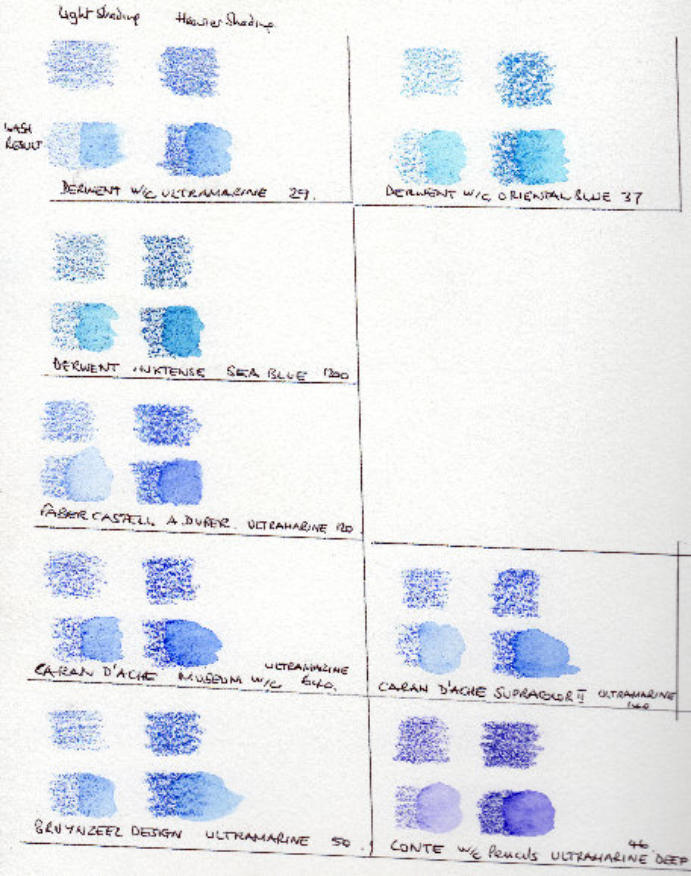
I have included an extra blue in the first set (Derwent Oriental Blue) and the Inktense sample is Sea Blue, which is the nearest to Ultramarine in that set. Inktense is a strong and permanent colour and more difficult to use for beginners, so I do not recommend it for our Venice tutorial.
What blue should we use for the sky?
I usually go for Ultramarine Blue (take care though, as we can see, this varies by manufacturer).
Why do I pick this colour? Ultramarine is a strong blue so we only need a little. Ultramarine is on the purple/red side (cold) of the colour wheel and suits a sky seen between cloud edges.
Derwent have the option of Oriental Blue, which tends to the green side of the blues. It is softer and warmer, and is also a strongly pigmented blue. Try to avoid pale blues as they usually contain a higher level of filler and are more difficult to work for this technique.
Options for painting the sky with watercolour pencils
This is a challenging area for watercolour pencils as they are designed to produce a line rather than a smooth even layer of colour. In our case we are also using a rougher paper than would be ideal, so the suggestions I offer should, in fact, cover you in a wide range of situations.
So, what sort of sky do we want?
The reference photo for the Venice scene shows a cloudy white/grey sky. If we opt for full cloud, then we don't really need to worry about painting the sky as the paper will serve left dry and white.
On a bright cloudy day, the sun is still the brightest part of the scene and I often leave the sky untouched. In the case of this tutorial that would be running away from the challenge and you wouldn't learn anything. So we will go for 'some' blue sky which gives us an excuse to use stronger shadows - as if the sky had gaps in the cloud cover letting strong sunlight through.
The Traditional Watercolour Option for Painting the Sky
If we stretch our paper it will open up a huge range of watercolour choices, as the paper can be seriously wetted and will not buckle. Once paper is evenly damp, it will accept pigment and allow it to flow and spread smoothly.
Check out our page on stretching watercolour paper if you want to use watercolour washes for painting the sky.
If you are not confident with the above, then we need to look at how we can get even colour down on to dryish paper with a surface grain and make the sky look realistic
My own preferred route is to avoid trying to make all the sky area blue, and treat it as if the sky has white cloud cover with some patches of blue sky showing. This can be very effective.
Using Watercolour Pencils Dry
We can take the 100% dry route by first scribbling the pencil onto a spare piece of watercolour paper, preferably rough, to make a 'palette'. The colour is then picked up with a piece of thick white felt and then rubbed gently into the drawing surface.
This will work best on a smooth surface, such as hot pressed watercolour paper and will not be as successful on cold pressed paper. But there is nothing to stop you trying it on a scrap piece.
Again, I would go for a strongly pigmented blue such as Ultramarine, but if you are also using Derwent Watercolour pencils you could opt for Oriental Blue, which is a green/blue.
This technique is covered in detail on the drawing clouds page where wax pencils were used in this manner.
You can erase the edges of the blue to make the clouds. This will give you a grainy result which can be very effective. DO NOT be tempted to add any water to this blue sky area - it will run the effect and the area which has been wetted will come up a very much stronger blue and spoil the balance.
Let's start painting the sky!
We must bear in mind that the sky is only a minor feature in the Venice scene we are working. We could easily complete the picture leaving white paper for the sky and no-one would query it. If we add colour, it needs to lie back and avoid attention. It just needs to be a small 'bit part' in the production.
I have suggested two options which make use of watercolour pencil techniques rather than pure watercolour methods.
- involves the working of a small patch of strong blue surrounded by white cloud
- involves the working of a small area of VERY pale blue a would be seen through thin cloud
1. small areas of strong blue in the sky area
So that you can see how to develop this method I have done a couple of practice sky portions below. The bits and pieces all need to be readily to hand, so that you can work quickly, and it will be easier for you as you won't need to have a camera in the other hand at the same time!
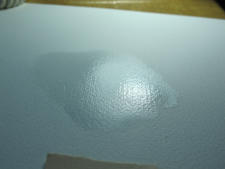

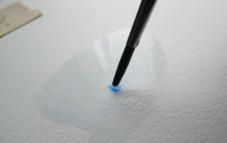
This first example shows a blue patch of sky showing between clouds. Firstly wet a small area of paper where you are going to place your blue patch of sky. Ensure that the paper is glistening damp, as shown. Whilst the paper is still damp, transfer a very small amount of colour, lifted from a paper palette of blue watercolour pencil pigment. This can be quite strong colour - but we are going to manage it and it will get paler.
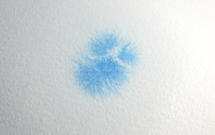
Here you see the result of fiddling with that small blob of blue colour...
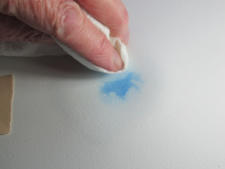
and after using a pad of kitchen paper to fade out the edges to indicate cloud
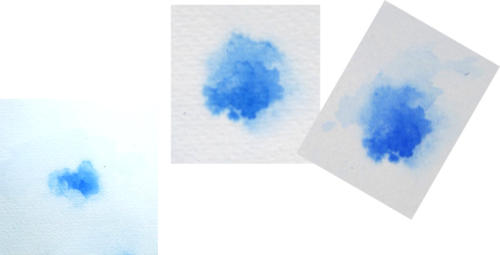
This will look different every time!
2. Working an area of very pale blue sky seen through a thin layer of cloud
This would normally be a problem area for pencils.
Stronger colours have purer pigments; paler colours usually have a lot of filler mixed with the pigment, which is white and does not respond as well to handling. We therefore need to find a way to apply a VERY small amount of pigment to the paper in an EVEN way.
Another problem is that we have selected a grained surface paper. It is much easier to get light layers of pale pigment on to a smoother paper surface. Once more, there are two options here.
First, we can apply the colour in a very think wash. However the paper should not be allowed to buckle with too much water. If we do not stretch our paper first this can prove tricky.
There is a second approach which works and uses the benefits and normal techniques for watercolour pencils (dry pigment on paper and damp brush applied). For this we must use some means of removing most of the pigment that the pencil will naturally apply VEGORE we add water.
This sound mad, I know, but I will show you how it works. We can use the aid of a blob of either blue/white tac, a white kneadable eraser or a piece of Scotch Magic tape.
What we are aiming for is this sample below left, not the second sample.
 We want this
We want this NOT this!
NOT this!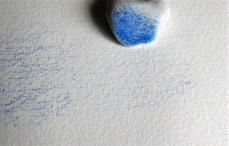
In this photo I have applied a VERY light shading of Ultramarine (Derwent) across the whole of the bottom of the paper area.
I have then dabbed the right hand and lifted colour from the paper surface onto the tacky blob. The blob lifts both colour and also presses some into the paper surface. The camera hardly shows any colour present on the right.
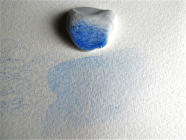
I can then take a damp brush and soften the very small amount of blue pigment left, washing it out over a small area.
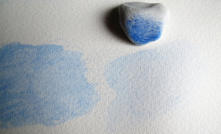
And to demonstrate the effectiveness of this process, I have now dampened down the pure colour on the left, which was untouched by the lifting process. You can see how much paler our colour has become. When working areas of your sky with this method, keep a pad of kitchen paper handy to ensure all your edges of blue are blotted out to avoid any hard edges.
WARNING: The area of colour shown on the piece of paper below is approx 10 inches wide by 5 inches high. This is about one third of the actual paper surface.
We would not normally need to apply water to an area this great in regular watercolour pencil techniques with the paper being stretched first. In this case I did not stretch the paper. Twenty four hours after the test, the paper has dried out thoroughly and there is a slight curve to the paper when the area was treated.
In retrospect I think it would have been better to have taped down the edges of the paper to hold it flat before applying water - no matter how little - to the paper surface. If you use this method and you are using paper supplied in block form, you should be fine.
If you are using loose sheets, or paper on a spiral bound pad, I suggest you secure the edges of your paper to a board while you are painting the sky. I still don't think stretching is absolutely necessary as we are using only a little water, but it is easier to take care, than worry about creating a problem later.
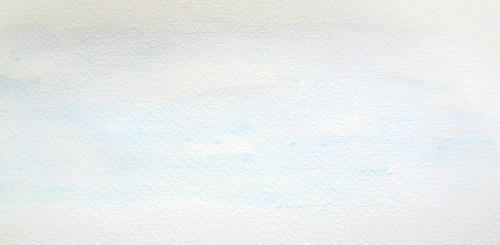
As you can see there is only a slightly random pale blue effect. These techniques should give you some options for painting the sky for your tutorial. Your sky will be unique, and practice beforehand will give you a better chance of a successful result.
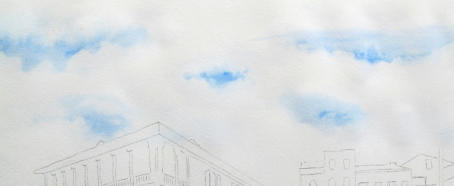
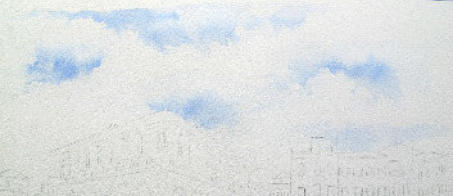
Here are two of my skies.
Even after tons of practice I still only get one out of two attempts that are suitable for developing into the picture. You may not do this well at first!
After completing painting the sky we will move onto looking at some of the buildings in our tutorial on the next page.
For more information about skies in the dartmoor landscape tutorial.
Improve Your Pencil Art: Get Free Tips & Techniques
Sign up for our newsletter – just occasional emails packed with practical advice and inspiration for pencil artists like yourself



















